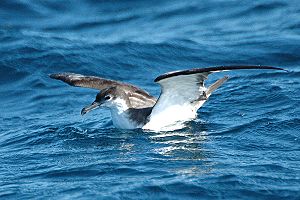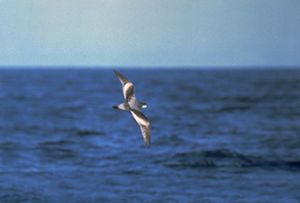Buller's shearwater facts for kids
Quick facts for kids Buller's shearwater |
|
|---|---|
 |
|
| In Hauraki Gulf (New Zealand), during the breeding season | |
| Conservation status | |
| Scientific classification | |
| Genus: |
Ardenna
|
| Species: |
bulleri
|
 |
|
The Buller's shearwater (Ardenna bulleri) is a cool seabird that lives in the Pacific Ocean. It's also known as the grey-backed shearwater or New Zealand shearwater. This bird is part of a group called seabirds known as shearwaters. They are famous for flying low over the water, almost "shearing" the waves. Buller's shearwater is one of the larger shearwaters and is closely related to the wedge-tailed shearwater.
Contents
What Does Buller's Shearwater Look Like?

Adult Buller's shearwaters are about 46–47 centimeters (18-18.5 inches) long. Their wings can spread out to 97–99 centimeters (38-39 inches). They usually weigh between 342 and 425 grams (12-15 ounces).
The top side of this bird is a pretty bluish-grey color. It has a blackish stripe that runs along its wings. The tips of its wings are also blackish. What's special is that these two black areas don't quite meet, leaving a lighter grey area in between. When you see the bird flying from above, this pattern looks like a broken black "M" shape.
The underside of the bird is bright white. On its head, the grey color from its back extends down to its eyes. Its cheeks are white and can look very bright. Its tail is blackish and shaped like a wedge. The bird's beak and eyes are dark. Even young birds look like the adults. Baby shearwaters are covered in soft grey down feathers.
It's usually easy to spot a Buller's shearwater at sea. Its large size and the unique "M" pattern on its wings make it stand out. Other birds with similar patterns are much smaller.
Where Do Buller's Shearwaters Live and What Do They Eat?
Buller's shearwaters live mostly far out at sea, like other shearwaters. They are "transequatorial migrants," meaning they travel across the equator. They can be found across most of the Pacific Ocean when they are not breeding.
You might see them in the cold northern waters off Kamchatka and the Aleutian Islands. They are also common off the west coast of the United States in late summer and early autumn. You can often spot them near the coastlines of North and South America.
These birds mostly eat fish, squid, and crustaceans (small sea creatures with shells), like krill. They sometimes follow fishing trawlers to find food. They usually catch their food right at the water's surface, either picking it up with their beak or briefly dipping their head into the water. They don't often dive deep from the air or from the water's surface.
Nesting and Family Life
Buller's shearwaters are "colonial nesters," which means they nest in large groups. They mainly breed on Tawhiti Rahi and Aorangi, the main islands of the Poor Knights Islands group off northern New Zealand.
These birds make their burrows (holes in the ground) in rock cracks or under tree roots. They prefer slopes covered in dense forests. However, they can also nest in cracked rocks on treeless stacks or cliffs. Other smaller colonies are found on the smaller Poor Knights islands.
The breeding season starts in October and lasts for almost half a year. The female lays a single egg. Both parents take turns sitting on the egg for about 51 days. They switch places every 4 days or so. We don't know exactly how long it takes for the young birds to be ready to fly (called fledging), but it's thought to be around 100 days.
Conservation and Population
In the past, the Māori people used Buller's shearwaters as a food source. On Aorangi island, the birds faced a big threat from feral pigs. By the late 1930s, their population on Aorangi had dropped to only 100-200 pairs.
Luckily, the pigs were removed from the island in 1936. After that, the shearwater population grew back. By the early 1980s, there were 200,000 pairs again! The colonies on other islands also helped supply birds to repopulate Aorangi.
Buller's shearwater has never been considered close to extinct. In fact, it's a very common bird, with an estimated world population of 2.5 million birds. However, because most of them breed only on the Poor Knights Islands, the IUCN classifies them as "vulnerable." This means that one big disaster in that area could wipe out the species.
See also
 In Spanish: Pardela dorsigrís para niños
In Spanish: Pardela dorsigrís para niños


